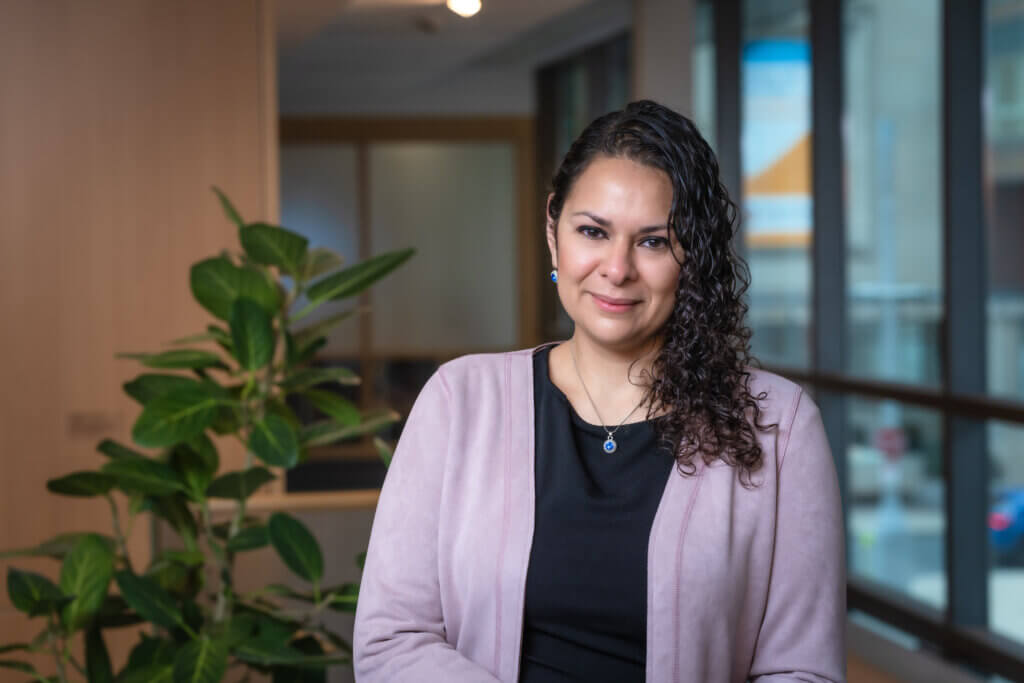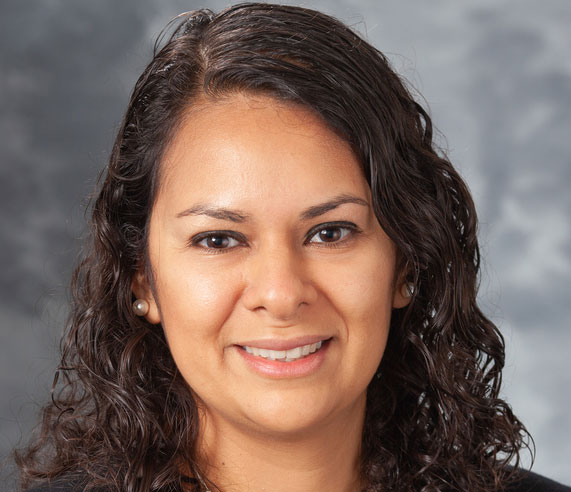In the past 25 years, cases of lung cancer have been rising among people without previous tobacco use. These cancer cases are approximately 2.5 times more likely to be found in women than in men. These women tend to be younger, and cases are rising more rapidly in people of Asian or Hispanic/Latina descent.

“Asian and Latina women without previous tobacco use are getting lung cancer, and they are getting it at younger ages,” says Dana-Farber thoracic oncologist Narjust Florez, MD, associate director of Dana-Farber’s Cancer Care Equity Program. “I am seeing patients who are 40, 25, 18, some with metastatic disease and with no previous tobacco exposure, first or second hand.”
More women die from lung cancer globally than from any other type of cancer. Two-thirds of adults who are non-tobacco-users with lung cancer are women. Dana-Farber does not yet have enough data to assess lung cancer trends among LGBTQ+ people, notes Florez, but that community tends to have higher smoking and vaping rates than the general population and are less likely to be offered lung cancer screening.
“It’s no longer a disease of men,” says Florez, who is developing a clinical trial at Dana-Farber that aims to assess the feasibility of a novel blood test to help screen more young people of Asian and Hispanic descent who might have a higher risk of lung cancer.
Why are cases of lung cancer rising in young women of Asian or Latina heritage?
One key risk factor is environmental exposures. Some of these exposures are more likely to occur in women who are Asian American or Hispanic/Latina because of cultural traditions or community locations. Exposures include:
- Exposure to burning oils and fumes in kitchens. Women from these groups are more likely to work in kitchens than those from other groups.
- Exposure to outside air pollution. Black, Asian, Latinx, Hispanic, and low-income populations in the US are more likely to be exposed to air pollution, which is a major risk factor for lung cancer.
- Exposure to radon, an invisible, odorless emission from the ground that can build up in basements and dwellings. Radon is less likely to be tested or remediated in rental spaces and in subsidized housing.
- Exposure to second-hand tobacco smoke. Women are more likely than men to be exposed to second-hand tobacco smoke.
- Exposure to radiation, for example, for the treatment of breast cancer.
“Lung cancer risk is not only about previous tobacco use,” says Florez. “Where you live and work can also increase your risk for lung cancer.”
Another risk factor is family history.
- The inherited genetic risk of lung cancer is low, but a person with a family history of lung cancer has an elevated risk of the disease.
- Gene mutations that drive cancer can also occur randomly throughout a person’s life. Mutations in the EGFR and KRAS genes, which drive lung cancer growth, are significantly more common in women, in people who don’t smoke, and in people of Asian descent.
Learn more about EGFR-mutant lung cancer care at Dana-Farber.
Is screening available for lung cancer?
Screening for lung cancer involves an annual imaging of the lungs using a low dose Computed Tomography (CT) scan of the chest. A CT scan uses low-energy X-rays to produce a series of detailed cross-sectional images.
Current United States Preventive Service Task Force guidelines set lung cancer screening eligibility at age 50 for people who have a history of smoking 20 packs of cigarettes per year.
Screening, however, often isn’t offered to patients, even patients with previous or current tobacco use. Studies suggest that only 10-15% of current or past tobacco users report having discussed lung cancer screening with their doctor. Women are 32% less likely to report that their doctor discussed screening with them.
What are the signs and symptoms of lung cancer?
The signs of lung cancer include:
- A cough that doesn’t get better.
- Shortness of breath that persists and is not explained by a recent illness.
- Back pain, particularly between the shoulder blades, that is not explained by injury or asthma.
- Coughing up blood
- Unexplained weight loss
If you are experiencing any of these symptoms, see your doctor immediately and ask to be evaluated for lung cancer.
Women and LGBTQ+ people may face delays in diagnosis, particularly if they are under 50 and have never smoked, because they do not meet the screening eligibility requirements. Doctors may consider lung cancer to be an unlikely diagnosis.
“If you have lungs, you can get lung cancer,” says Florez. “I have patients that have been told it’s impossible for them to have lung cancer when they say, ‘Could this be lung cancer?’ This bias results in delays of diagnosis and subsequent limited treatment options.”
Learn about how lung cancer is treated at Dana-Farber.
What research is Dana-Farber doing to help address this rise in lung cancer cases?
Florez and colleagues are developing a blood test that could be used to screen more younger individuals of Asian or Hispanic/Latinx descent who are non-tobacco-users for lung cancer. These historically marginalized groups are at an elevated risk for EGFR-mutated non-small-cell lung cancer.
The blood test, developed at the Robert and Renée Belfer Center for Applied Cancer Science at Dana-Farber, collects circulating free DNA (cfDNA), which are fragments of DNA shed from cells that have died. The test is designed to use PCR testing – the same kind of testing used to detect infections such as COVID-19 – to detect the presence of known EGFR mutations associated with lung cancer.
Florez and colleagues have designed a clinical trial to determine the feasibility of using the blood test to identify early or locally advanced EGFR-positive non-small-cell lung cancer in non-tobacco-using healthy East Asian and Hispanic/Latinx individuals. The study is part of a larger effort to understand more thoroughly the rising numbers of lung cancer cases in East Asian and Hispanic/Latinx communities.
“Our hope is that we will be able to determine if this test helps us diagnose patients early, since they are at a high risk for lung cancer but don’t qualify for traditional lung cancer screening,” says Florez.
Learn more about clinical trials in lung cancer at Dana-Farber.
About the Medical Reviewer

Dr. Narjust Florez is the Associate Director of the Cancer Care Equity Program and a thoracic medical oncologist at the Dana-Farber Brigham Cancer Center. She completed her internal medicine residency in Rutgers New Jersey Medical School and fellowship at the Mayo Clinic in Rochester, Minnesota where she was the chief fellow from 2018-2019.
Dr. Florez's clinical interests include targeted therapy for lung cancer and the care of women with lung cancer, including their unique aspects of cancer survivorship. She is the principal investigator of the Sexual Health Assessment in Women with Lung Cancer (SHAWL) Study, the largest study to date evaluating sexual dysfunction in women with lung cancer.
Apart from her clinical interests in lung cancer, she is also a leading and productive researcher in cancer health disparities, gender and racial discrimination in medical education and medicine. She received many awards including the 2018 Resident of the Year Award by the National Hispanic Medical Association, the Mayo Brothers Distinguished Fellowship award and the 2020 Rising Star award by the LEAD national conference for women in hematology and oncology.
In addition, Dr. Florez founded the Florez Lab in 2019. The laboratory focuses on lung cancer, social justice issues in medicine and medical education. The laboratory long-term goals are to create a welcoming environment for medical trainees from historically underrepresented groups in medicine while improving the care of vulnerable populations. Members of the Florez Lab are agents of change.

I got NSCLC in 2016 at age 60. I told my PC for 2 yrs something was wrong. My hair was falling out like mad. I made her test me for all vitamins as I thought I must be lacking. Now that I know more I should have shown her my little finger finger n sils that were turned down and now I see my eyelids are dropping which is another sign of LC. By the time I started coughing nonstop which was after 2 yrs of feeling odd, my sis told me to get a chest xray nd I was stage 4. I’m not a smoker. Turns out my family has a cancer gene Tp54. My onc says he doesn’t know why I got this cancer and isn’t sure it’s the gene. Luckily I’m still doing well on Tagrisso after 7 yrs. Had 1 yr on Tarceva. Praying my drug works forever cause I want my whole life. But please make them test all girls not just smokers.